Why is it monitored?
Industrial and human activities involving radioactive substances are likely to result in radioactive releases to the environment, either as part of their normal operation or as a result of operational incidents or accidents. These activities are monitored via automatic devices or via samplings, to make measurements of the environmental radioactivity.
In summary, the radiological measurements carried out in the environment in France by the different stakeholders of the monitoring, meet four objectives:
- Objective 1: Verify that the activities involving radioactive substances are carried out in compliance with regulatory requirements.
Nuclear activities are authorized to release radioactive substances into the air or aquatic and marine environments under defined and controlled conditions. These authorizations are issued by the competent regulatory authorities after a prior assessment of the foreseeable impact on the environment and population health.
- Objective 2: Rapidly detect any increase in radioactivity in the environment
This involves the detection of any accidental release of radioactive substances into the air, water or soil, even when the discharge takes place outside the national territory (e.g. Chernobyl or Fukushima accidents).
- Objective 3: Know the radiological status of the national territory
Regular monitoring of changes in environmental radioactivity over time enables to precisely characterize levels in all environmental compartments and identify their origins: operating nuclear facilities, past pollution (polluted sites, atmospheric fallout following nuclear weapons tests and the Chernobyl accident, etc.), or natural radioactivity.
- Objective 4: Contribute to the assessment of population exposure
The study and monitoring of radioactivity levels present in the environment are essential for assessing the impacts of radioactive substances on human health, the environment (ecosystems), and resources of economic interest (particularly water and agriculture).
 return to top
return to top




